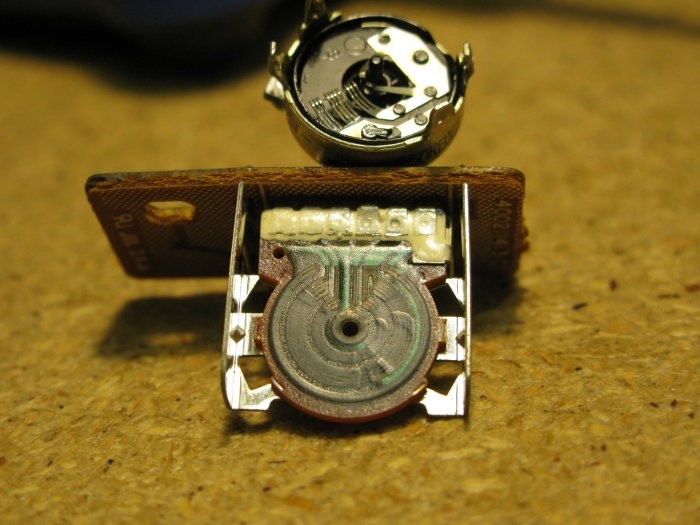I pulled apart a crackling volume knob to see if I could see the problem and the carbon resistance trace is almost gone down near the circuit board. It probably had around 15 years of heavy use.

I pulled apart a crackling volume knob to see if I could see the problem and the carbon resistance trace is almost gone down near the circuit board. It probably had around 15 years of heavy use.

The bookshelf speakers I showed some work on a while ago (including hole cutting) are on the move again. Lots of firsts for me including a ground up 12dB per octave crossover network engineering job. I did it starting with text book values and did it from there with measurement (no impedance compensation used). Quite a hassle and I now have better means for doing it with speakers I have proper data for. More to come.
Anyway, here is the high pass filter (for the tweeter).

I drilled a hole in the base under the inductor and the hot glue flowed down into it. Hope it will be durable. the resistors are tacked down with superglue in case they get at all hot. However, I expect them to dissipate very very little power (compared to their ratings). Burned my thumb with the hot glue too 😐
Here is the prototyping.

I measured my speakers with HOLMImpulse. Don’t worry to much about the absolute amplitude of the tweeter and woofer, I moved the microphone around a little to get the cleanest data on each of the two drivers. The magic of active crossovers shown for all to see.
The impulse response ‘reflects’ the fact that the left speaker was tested much closer to a side wall than the right.
The measurements showed a marked dip at the crossover frequency when I had the woofers and tweeters wired ‘in phase’. I am not sure why. They are 4th order crossovers and should not behave like this. Both left and right speakers were the same. I will get to the bottom of this some other time. It could be a wiring error (a symmetrical one…) a combination of the tweeter protection cap and the physical position of a tweeter (further forward) or something else. For now it sounds great.
This thing is tops. The UI is a little rough but pretty much set and forget. Temperature settings survive a full powerdown 🙂 Cheaper irons with less ability to get heat to the tip are more likely to need turning up for heavier items, this thing should just hold up to the load.
Ordered it with a couple of T18-D16 chisel tips based on EEVBlog videos (the guy is a legend) plus some others and some .5mm rosin core lead free solder (again on the EEVBlog recommendations, I had been using thicker stuff). I know it is easier to get better results with lead but, um, no thanks.
Some time ago I built a 24dB per octave crossover (you can see it in one of the first of my blog posts). I originally had my two way speakers hooked up via a cheap 4 x 100W switchmode amplifier from Sure electronics. It was good I thought I could do better.
I set up a four channel amp based on the excellent but modestly powered TDA7294 with a UPC1237 plus relay speaker protection circuit.
It did not do quite what I thought it would. I expected better treble but was disappointed. Then the left tweeter became intermittent and then the right too (though not as bad). What to do?
First I suspected a blown tweeter from a few nasty crossover turn on transients (I am still working on that problem and think an easy answer lies in an arduino relay board rather than try and isolate the relays and their flyback voltages using custom boards or point to point wiring). However a second tweeter, wired in parallel with the intermittent one, failed at the same time (and a short circuit was unlikely.)
After months of fiddling on and off (sometimes the fault would go away for a week) I pulled the amp out from under a bunch of stuff, including a laser disc player for example, and found that bumping an amp board sharply would fix the problem and bring back extra detail if the tweeter was already working. The speaker protection relays were surely the culprit. As of right now it seems confirmed.
I think the problem is that the power levels sent to a tweeter (crossed over at 2khz) were so low that they could not break down an insulating layer of oxide/crud on the relay contacts. Embolded by information I found on the web I connected the woofers up to the tweeter amps and cycled power to the amp while playing a loud 100hz tone. Rough measurements (current clamp meter) suggested I was switching about 2A at about 20V at the speaker protection relay, I did this about a dozen times. Looks like the arc burned off the crud. The amps sound fantastic too. WIN!